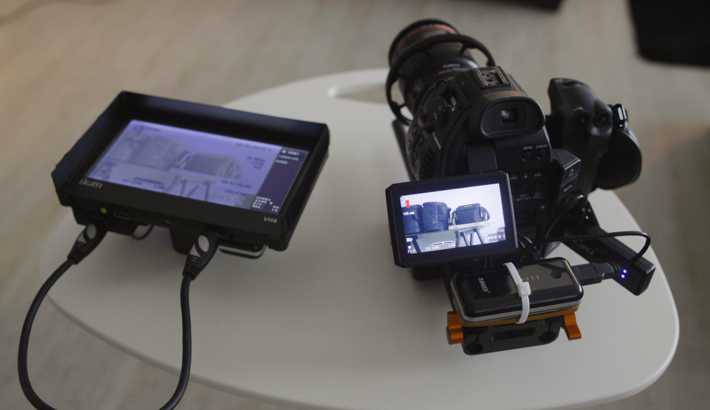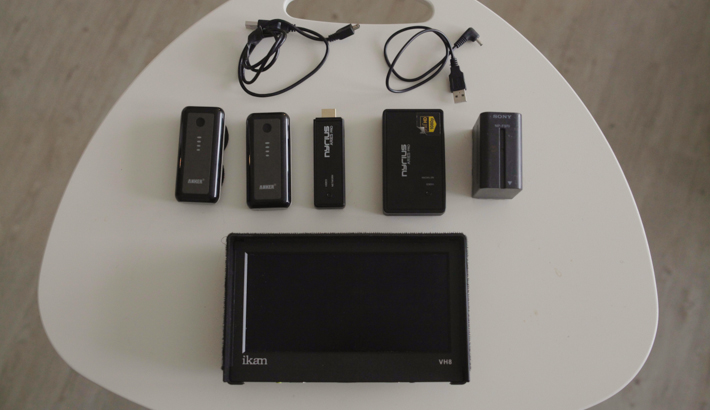As consumer electronics continue to improve in quality and price, there are more opportunities for professionals to save some money and create DIY solutions. I thought it would be worth sharing my latest DIY project (inspired by video director Joe Simon). I shoot quite a bit of commercial work and often have agency reps or clients that need to view takes and give feedback. This often means a very “cozy” experience around the monitor.
Last year, I decided to start bringing extra monitors and 20 foot HDMI cables on set. This was a great way for everyone to get their own view of what was happening on screen. The big downside to the HDMI cords was the constant tripping hazard.
This year, I decided it was time to research a wireless solution for my existing monitors. The Paralinx arrow is a great sub $1000 option. It offers zero latency 1080p HDMI transfer across hundreds of feet. It is also fairly light; meaning that my steadicam would remain fairly unaffected by the extra weight.
As mentioned before, It was Joe Simon that shared his solution. The core of Joe’s system is the Nyrius Aries Pro Wireless HDMI system. The first thing you’ll probably notice when checking out Nyrius' system is that it looks nearly identical to the Paralinx Arrow.

One benefit of the Nyrius system is that it allows for USB powering. This means that users can power the product with cheap consumer USB bricks (often used to charge phones or laptops). I personally chose Anker Astro batteries based on their small size and great reviews.

My experience with the wireless setup has been great so far. The Nyrius unit has zero latency and a great wireless range. More importantly, my clients are impressed and I don't have to worry about clients or talent tripping over HDMI cables.
If you’re interested in building a similar wireless HDMI monitor, here is a list of the parts I used:
Nyrius Aries Pro (comes with HDMI cable) (On sale for $249.99)
Paralinx Arrow Reciever Power Cable ($9.00)
2x Anker USB Power Bricks ($26.99 each)
It's also helps to have a rail system to mount the batteries to. (Find one that works with your camera)

Best of luck guys. Drop me a line on twitter or in the comments below if you have any questions.







I am glad to see wireless video is getting better. This kind of stuff is great to use for my photobooth setups.
that makes me tingly.....ya know......down there
...
You can monitor and control DSLR wirelessly from a smartphone or tablet for about $38 with the DSLRControl app (for Canon) and a TP-link battery-powered wifi router: www.youtube.com/watch?v=xnlYzt6zcpw
Yep that's pretty awesome as well. Personally I wouldn't use this because of it's range, lower frame rate and quality loss. 1080p and low latency makes a huge difference for pulling focus or properly timing your actors.
Still, I can't argue that this is awesome for a budget DSLR shooter.
I was an early adopter of the CamRanger but I looked up other possible hacks before I bought one. I encountered suggestions about hacking this particular router but with no actual working one provided, I decided to bite the bullet and buy the CamRanger. I'm kinda annoyed that it was this simple. Purchasing an Android tablet powerful enough to run the DSLRController app as well as the app itself would have been a lot cheaper and you could use the tablet for other things as well. I know that this would have worked even back then cos the app was around for much longer than the CamRanger.
What I'd like to know from anyone who's tried this is if you can control a motorized head the way you can do with the CamRanger (once you purchase the hub accessory)?
When I buy mine, I'll try to find out since I also own the Bescor pan/tilt head they designed it around.
Sounds good. BTW I can't find the DSLRController app on the App Store so I think it remains to be an app for Android devices only. You're right about the Bescor head. Not just designed it around, it's the actual head, but I think that an accessory called the PT hub is needed to control the head wirelessly and through the iOS/Android/PC/Mac controller. You can check out CamRanger's site to see what the hub looks like and if there are similar gadgets in the market. They have the head/hub for sale at under $200 so I bought it from them too since the head alone would probably come close to the price if I got it on ebay and the head or hub alone for around $120 each if I got it from them.
Think its cool, but why not just buy a CamRanger for $50.00 Extra. and have full control over your DSLR along with monitoring it.
I'm not shooting with a DSLR.
I guess.... I mean for others who are looking for a way to view with DSLR. It's very cool system. at a great cost. I'm assuming once this catches on more in the future we will see this wireless viewing being built in most pro type camera and camcorders in a few years possibly.
Might have spotted a mistake? The Nyrius Pro is actually this one.
http://www.amazon.com/Nyrius-Wireless-Transmitter-Receiver-NPCS550/dp/B0...
Different from the one in the link you gave. It's going at $250.
Still.. I wonder if anyone has tested the difference between this and the paralinx? I've got a Paralinx Arrow Plus, and the range to be really good needs to be line of sight. So I'm wondering if this is actually the same thing.
Good catch. Updated that link! In my testing, the range and latency on the Nyrius unit is stellar. Probably not quite as much range as Paralinx, but good enough for my needs.
nice!
Found them in the UK but can't locate the power cable! Any suggestions?
http://www.amazon.co.uk/Nyrius-Wireless-Transmitter-Receiver-NPCS550/dp/...
http://www.amazon.co.uk/Portable-External-Built-In-Flashlight-smartphone...
Wow, nice. I'm definitely doing this for my next shoot. I'm sick of cables!
how long is the delay?
There are 2 companies, CamRanger and Sanho-iUSBport, that provide wireless tethering with either an iOS or Android device. The CamRanger can even be controlled through a PC or Mac while the Sanho can even serve as a wireless router of an external disk. How does this setup compare to those systems?
FWIW while the video taken with these systems is normal, the viewing experience as a monitor is rather choppy.
What is the difference between the Pro and non-Pro versions of the unit? The non-pro is much cheaper but trying to work out if the Pro is worth shelling out the extra cash for.
the video transference ( real time? )
Dave, How long does those Anker power bricks last ya? Great post/idea btw.
I've been finding around 4-5 hours. However, they're cheap enough to buy a few of!
i bought this system and can't get it to work w/ my mark iii and small hd monitor.. i did some trouble shooting and it works fine via laptop to standard monitor but not laptop to small hd monitor and won't work from mark iii to tv monitor either.. anyone else having issues?